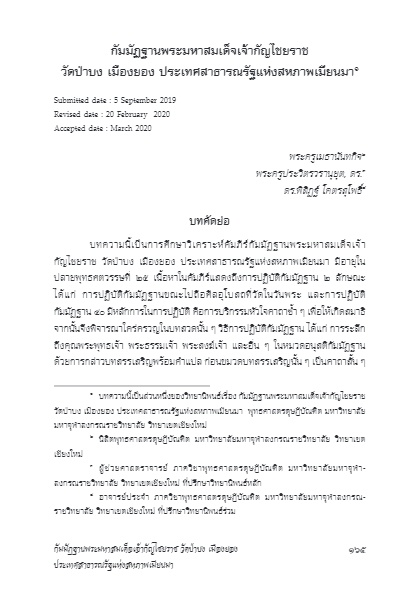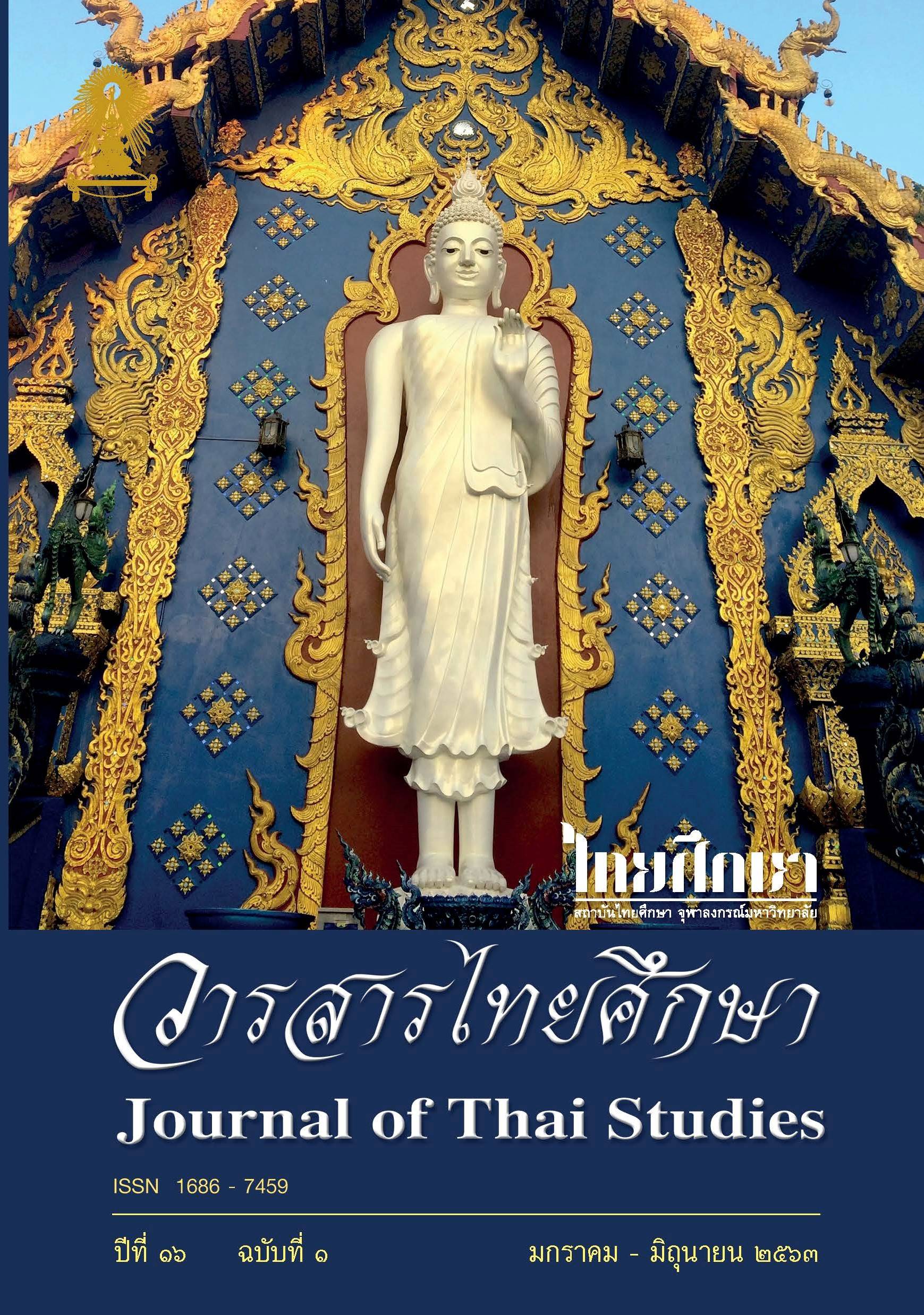กัมมัฏฐานพระมหาสมเด็จเจ้ากัญไชยราช วัดป่าบง เมืองยอง ประเทศสาธารณรัฐแห่งสหภาพเมียนมา
พระครูเมธานันทกิจ
พระครูประวิตรวรานุยุต,
พิสิฏฐ์ โคตรสุโพธิ์
บทคัดย่อ
บทความนี้เป็นการศึกษาวิเคราะห์คัมภีร์กัมมัฏฐานพระมหาสมเด็จเจ้ากัญไชยราช วัดป่าบง เมืองยอง ประเทศสาธารณรัฐแห่งสหภาพเมียนมา มีอายุในปลายพุทธศตวรรษที่ ๒๕ เนื้อหาในคัมภีร์แสดงถึงการปฏิบัติกัมมัฏฐาน ๒ ลักษณะ ได้แก่ การปฏิบัติกัมมัฏฐานขณะไปถือศีลอุโบสถที่วัดในวันพระ และการปฏิบัติกัมมัฏฐาน ๔๐ มีหลักการในการปฏิบัติ คือ การบริกรรมหัวใจคาถาซ้ำๆ เพื่อให้เกิดสมาธิ จากนั้นจึงพิจารณาใคร่ครวญในบทสวดนั้นๆ วิธีการปฏิบัติกัมมัฏฐาน ได้แก่ การระลึกถึงคุณพระพุทธเจ้า พระธรรมเจ้า พระสงฆ์เจ้า และอื่น ๆ ในหมวดอนุสติกัมมัฏฐาน ด้วยการกล่าวบทสรรเสริญพร้อมคำแปล ก่อนขมวดบทสรรเสริญนั้น ๆ เป็นคาถาสั้นๆ เรียกหัวใจคาถา จากนั้นจึงบริกรรมหัวใจคาถาพร้อมนับลูกประคำไปเรื่อย ๆ จนจิตเป็นสมาธิ แล้วจึงค่อยพิจารณาใคร่ครวญในคำแปลของบทสวดแต่ละบท มีลักษณะเฉพาะ ๓ ประการ คือ ๑) ให้ความสำคัญกับการชำระล้างจิตใจด้วยคาถาก่อนเข้าสู่ขั้นตอนการปฏิบัติกัมมัฏฐาน ๒) วิธีการภาวนา โดยเมื่อบริกรรม “พุท” ให้รับรู้การเคลื่อนไหวของลมหายใจเข้าที่ปลายจมูก เมื่อบริกรรม “โธ” ให้รับรู้การเคลื่อนตัวของลมหายใจผ่านลำคอ หัวใจ ลงสู่ท้อง ๓) วิธีนับลูกประคำ ให้วางลูกประคำไว้เหนือตัก โดยให้นับลูกประคำ ๑ เม็ด ต่อคำภาวนา ๑ คำ เช่น พุทโธ เป็นต้น
คำสำคัญ: กัมมัฏฐาน; พระมหาสมเด็จเจ้ากัญไชยราช; วัดป่าบง เมืองยอง ประเทศสาธารณรัฐแห่งสหภาพเมียนมา
(ตีพิมพ์ใน วารสารไทยศึกษา ปีที่ 16 ฉบับที่ 1 (มกราคม-มิถุนายน 2563) หน้า 165-188)
Kammatthana Scripture of Phra Maha Somdej Chao Kanchaiyarat, Wat Pa Bong, Mueang Yong, Republic of the Union of Myanmar
Phrakhu Maytanantakit
Phrakru Pravitvaranuyut
Phisit Kotsupho
Abstract
This article is an analysis of the kammatthana meditation scripture of Phra Maha Somdej Chao Kanchaiyarat, Wat Pa Bong, Mueang Yong, Republic of the Union of Myanmar in the late 25th century of the Buddhist era. The contents of the scripture represent two aspects of kammatthana practice: practicing kammatthana meditation while keeping the eight precepts at a temple on Buddhist holy days and forty meditation subjects. Kammatthana meditation practice includes the remembrance of the Buddha, dhamma, sangha and others in the category of anusati kammatthana meditation, followed by reciting the text and counting the rosary. The unique kammatthana meditation characteristics of Phra Maha Somdej Chao Kanchaiyarat include three aspects: 1) a procedure for focusing on mind cleansing before entering kammatthana mediation, including sacred words to purify and extinguish sin from the mind; 2) for the praying method, when saying “bud”, one must recognize the movement of the breath coming through the nose, and when saying "dho", one must acknowledge the movement of the breath coming through the throat, heart and into the stomach; 3 ) counting the rosary can be conducted by placing the rosary above the lap and by counting one rosary bead per one prayer, such as saying “Buddho”.
Keywords: Kammatthana mediation, Phra Maha Somdej Chao Kanchaiyarat, Wat Pa Bong, Mueang Yong, Republic of the Union of Myanmar.
(Published in Journal of Thai Studies Volume 16 Number 1 (January-June 2020) Page 165-188)
บทความ/ fulltext : 6_Phakru.pdf






